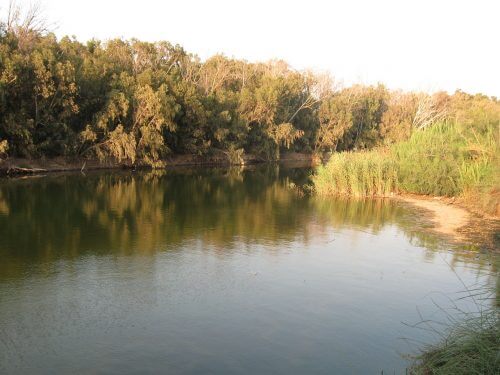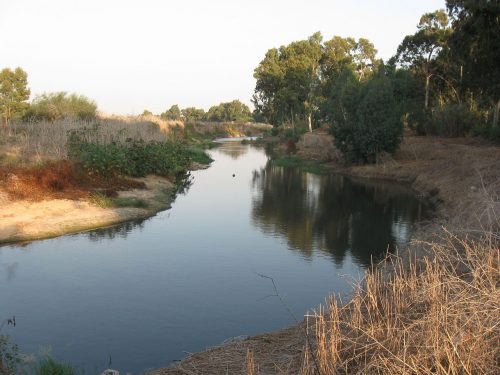How can a neglected river bank be turned into a vital habitat in a short time? A treatment method using beneficial bacteria developed in Japan helps the rapid development of local vegetation in Nahal Sorek

by Itai van Rijn, angle, news agency for science and the environment
Anyone who has traveled in recent years in Nahal Sorek, has surely seen the signs of years of pollution and neglect. In the area of the river's mouth, near Palmahim beach, the banks of the river are exposed and devoid of vegetation, and subject to constant erosion with the arrival of the floods in winter. Eucalyptus trees uprooted from the loose soil are lying in the path of the flow, and large blocks of soil are still attached to their roots. The mouth of the river, which used to have water flowing through it most of the year, has experienced difficult years in which the flow of water was interrupted and runoff water replaced the rainwater and springs. In addition, long-term use of herbicides on the banks of the stream has led to a reality where seeds in the ground are unable to germinate.
A healthy stream is like a machine: all components are essential for its proper operation. Invertebrate predators, fish and amphibians, for example, regulate mosquito populations, and in their absence these multiply undisturbed and become a nuisance. In the same way, developed vegetation on the banks of the stream sends out roots that stabilize the soil and prevent erosion, and even allow for the slowing down of the flow speed and sedimentation of silt. Riparian vegetation such as goma species, which are resistant to flooding, will be found near the flow path, and up the bank will appear a large variety of herbaceous plants and shrubs, which characterize moist habitats that benefit from an increased water supply.
Recently, an attempt was made to think outside the box in dealing with the restoration of the river vegetation. After it was clarified that the natural vegetation does not develop in the polluted soil, and it seems that the process of restoring the stream requires a preliminary process of "healing" the soil, an experiment was started in which they used "beneficial" bacteria - a method that originated in Japan - and after a successful experiment conducted in recent years, the method will be implemented as part of a bank restoration project The stream and the swamp in the area of the mouth of Nahal Shork.
Beneficial bacteria instead of chemicals
The project to restore the shores of Nahal Sorek and the restoration of the wetland landscapes is the result of an initiative of the Environment Division in the Science Division of the Nature and Parks Authority, led by Avi Ozan, a humid habitats ecologist, and Nissim Keshet, Director of the Environment Division. The Sorek-Lakhish Drainage and Rivers Authority also joined the initiative and financing of the project. Uri Moran from the company "Moran Consulting and Development", which deals with the planning and restoration of natural habitats, planned and managed the pilot and research project.
In the first stage, it was decided to carry out a pilot project, due to the many challenges of restoring the river. "The challenge was to find a way to restore the bank's vegetation in the short window of time between the end of the flood season, around March-April, and the beginning of the October-November floods," explains Moran. "The accumulation of herbicides over the years caused the sterilization of the bank, to a level where even invasive vegetation did not grow."
Following previous experience, it occurred to Moran to test a new technology as part of the pilot, in which bacteria and other microorganisms help to restore the soil. This collection of microscopic creatures is called a machine "Beneficial Microorganisms" Or for short EM, short for Effective microorganismsTM.
The story of the beneficial microorganisms begins on the island of Okinawa in Japan, where Professor Teruo Higa concocted a composition containing over 80 types of microorganisms, which forms the basis of the preparation used today. Since then, EM has been used as a soil additive in agricultural fields and organic gardens, to improve the growth of agricultural crops while avoiding the use of chemical substances, which may harm the environment. At the same time, the effectiveness of the microorganisms has been proven in the restoration of habitats and the removal of polluting substances from soils. Egyptian researchers found, for example, because adding the EM component to soil contaminated with herbicides resulted in cleaning up to 90 percent of the materials in laboratory experiments.
The return of the gumma

Experimental plots were established on the banks of Nahal Sorek, where different methods of soil treatment were compared: treatment using beneficial microorganisms, treatment using substances such as activated carbon and chemical fertilizer, and control plots. "The experimental plot extends 100 meters to the banks of the river, and the final project is expected to include about two kilometers," says Asher Maimon, who is involved in the research and marketing of EM components and works in collaboration with farmers (organic and conventional), environmental educators and various environmental organizations.
In the first step, the entire area was thoroughly surveyed to understand the properties of the soil. In a second step, local vegetation was planted in the experimental plots. "Expert botanists collected seeds from the river area and similar areas, and the seeds were germinated in the nursery," Maimon explains. "Research is required here as well, because each seed has different germination conditions." After that, the plants were planted in the experimental plots: a total of over 32 species of plants were planted, including four species of gum, local shrubs and herbs.
In the months after planting, the researchers followed the development of the plant in the experimental plots. It could be noticed that in the plots that were enriched with the beneficial microorganisms, the vegetation developed at a faster rate. Resistance to soil erosion is one of the main goals of the restoration project, and for that a developed root house is needed; One of the species that was planted was flea Laxative, a perennial herb typical of stream banks and blooming yellow in the summer months. Through painstaking manual labor, the researchers pulled out several bushes of this species from the experimental sections, while being careful to preserve the integrity of the root system. A comparison between the plots showed that the action of the microorganisms was also manifested in an increased growth of the roots.
The total plant mass in the plot treated with EM was also significantly greater, reaching four control sections and twice that of treatments where the plots were manured or activated carbon was incorporated. "The importance of rapid development for the restoration of banks is great. This means that the soil grip is good," Moran explains, emphasizing that this fact will help deal with the limited window of time between the flooding seasons.
Another and more surprising observation was the appearance of vegetation that sprouted from local seeds. "We watched the development of about 40 additional species beyond the ones we planted, which sprouted from the seed bank in the soil, which had been there for many years," explains Moran. "This is of great importance, because it shows the restoration of the land - when it turns from barren land to vital land."
From Japan to Israel and back
In a world where there is a great fear of the outbreak of invasive species that came from distant places, is there no fear of introducing "foreign" microorganisms into the soil in Israel? Calming funding: ” EM contains primitive microorganisms, which exist everywhere on our earth, all over the world. Some say that these are varieties from the time when there was only one continent here. Evolutionarily speaking, the same ancient strains still exist everywhere. Along with them, at the same time, a very large variety of local microorganisms has developed over the years. The goal in working with EM is not to transplant foreign microorganisms that come in containers from abroad, but to create an environment that outlines the direction for the other microorganisms in the place, and thus, over time, the restoration is created."
Maimon recently presented the results of the experiment at an international conference on sustainability and the environment held in Japan. "The conference is of the branch of MIT University in Japan," says Maimon. "Environmental issues, green technology and smart cities are presented at the conference". The conference brings together experts from around the world who study the action of the beneficial microorganisms. According to Maimon, this is an expression of a process of scientific recognition of the benefits of using beneficial microorganisms. "EM is slowly breaking into the West, and there is a trend of recent studies being conducted on the subject in Europe and the United States."
This week, the Fund for Open Areas approved the funding that will allow progress to be made in the project to restore the river and the Shork Swamp. "In addition to the project at Nahal Shurk, EM will be integrated into the Nahal Bohu lake project in Netivot and the restoration of the Gaon Yarakon area," says Maimon. It seems that Prof. Higa's beneficial microorganisms are starting to take root in Israel as well.
